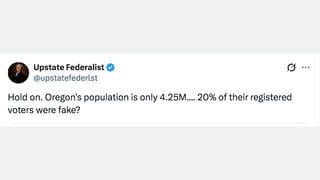
Were 7 million people registered to vote in the 2020 general election in Wisconsin when only 4.5 million were eligible voters? No, that's not true: There were more than 3.9 million registered voters and an estimated 4.5 million eligible voters in that election, a Wisconsin Election Commission (WEC) representative told Lead Stories.
A version of the claim made by former Wisconsin Supreme Court Justice Michael Gableman was reported in an article published on September 8, 2023, (archived here) by The Star News Network titled, "Explosive Testimony from Former Wisconsin Supreme Court Justice at Disbarment Trial of Trump's Attorney John Eastman." It read, in part:
Gableman was directed by the Wisconsin Legislature to conduct a minimal investigation of the 2020 election, and he revealed numerous instances where he believed the law was broken, and had election officials referred for prosecution.
Below is how the post appeared at the time of this publication:
 (Source: thestarnewsnetwork.com screenshot taken Tue Sept 12 16:08:11 UTC 2023)
(Source: thestarnewsnetwork.com screenshot taken Tue Sept 12 16:08:11 UTC 2023)
The Star News Network is a network of sites that NPR reported is seeking "to influence local politics with conservative opinion by mimicking the look and feel of local newspaper sites." The article above was also shared in posts on X to suggest the supposed findings of Gableman -- who has ties to former President Donald Trump -- proved some sort of election fraud.
A Lead Stories analysis of Wisconsin voter records proved otherwise.
Examining the Wisconsin voting record database
Wisconsin had 3,684,726 active registered voters on November 1, 2020, based on figures published by the Wisconsin Election Commission (WEC). This increased to about 3.9 million after people registered on Election Day.
The "7 million" figure cited by Gableman included all people recorded in the Wisconsin voter database, which also contained those who were deactivated and who would have needed to re-register to vote, a WEC public information officer, Riley Vetterkind, told Lead Stories in an email received on September 11, 2023.
Ineligible voters must re-register
Ineligible (inactive) voters are not registered to vote, whether absentee or in-person. Voters who wish to become registered again must re-register and create a new record. They cannot simply "reactivate" their record and no mechanism exists for voters to do so. In general, once a record is deactivated, it stays that way. Only in narrow and well-documented circumstances may an inactive record be re-activated.
Eligible (active) records are voters who are registered to vote, appear in poll books and can cast a ballot in statewide elections, wrote the WEC in a statement published online on September 17, 2021.
A voter's registration status may be modified from eligible to ineligible for various reasons by officials with the statutory authority to do so. Wisconsin has had a statewide voter registration list since 2006, and state law requires the WEC to conduct voter list maintenance every two years after each general election.
Requirements for maintaining voter records differ by state. Wisconsin law requires that an active (eligible) and inactive (ineligible) voter list be maintained in a database and managed by more than 1,800 municipal state clerks as part of the historical public record.
Fraud not proven, professor says
Trey Hood, a professor in the Department of Political Science at the University of Georgia, told Lead Stories that the Star News article does not prove fraud occurred during Wisconsin's 2020 general election.
"There could be a number of reasons for [Gableman's reported] discrepancy," he wrote in an email received on September 11, 2023. "If the voter file contained canceled registrations (had not been cleaned), it would inflate the numbers. Such registrants are not eligible to vote. These would be people who had died or moved out of state or would be ineligible for felony convictions."
Voter database
Vetterkind referred us to the 2020 General Election Voting and Registration Statistics Report database published on November 4, 2020. Here's how we broke down the numbers:
-
First, click on the spreadsheet titled, "2020 General Election (EL-190F) Election Statistics Report 2021-05-10.xlsx."
-
The total number of registered voters for that election can be found by adding together the "open registrants," "late registrants," and "Election Day registrants" columns. The total is approximately 3,915,589 voters.
-
As the columns imply, the figure above refers to voters who had registered before Election Day (and remained registered) as well as those who registered on Election Day.
Vetterkind said, "Estimated eligible voters is an entirely different figure. This refers to people aged 18 and above, as estimated by the Demographic Services Center of the Wisconsin Department of Administration. For the 2020 General Election, the estimated number of eligible voters was 4,536,417." (That figure is referenced here by clicking on the link, "Voter Turnout Partisan-NonPartisan Through November 2022.xlsx.")
Such record retention laws prevent an abuse of the system
Retaining public records helps to safeguard against abuse of the system, wrote the WEC, adding that:
If ineligible records were destroyed, the State of Wisconsin would have no voting history. There would be no registration history, no participation history, and most importantly, no history of why a record became ineligible. The voter registration database is the means for election officials to track deaths; to track felons; to track people adjudicated incompetent; and to otherwise track any reason for ineligibility. If ineligible records are destroyed, election officials would lose their only mechanism to verify these conditions.
Anyone is able to independently verify the status of ineligible records and note changes to active status because all voter registration data, both active and inactive, is available to the public.
Lead Stories has debunked other claims of purported election fraud in Wisconsin, including that the state had an 89 percent reported voter turnout in the 2020 election, that a large drop in Wisconsin's active military votes between 2020 and 2022 suggested fraud and that there was "shocking evidence of widespread fraud" in Wisconsin's voter database.















